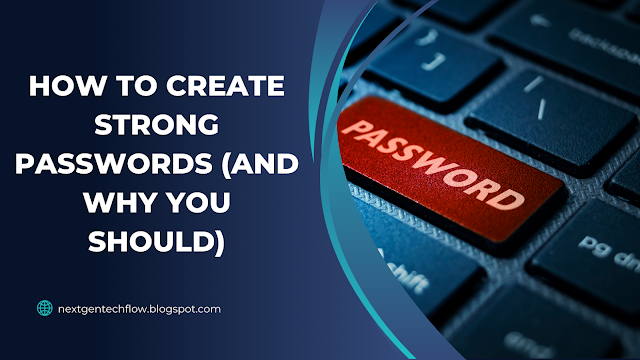
|
| How to Create Strong Passwords (and Why You Should) |
Table of Contents
In today’s digital age, cybersecurity threats are more prevalent than ever. A strong password acts as your first line of defenceoutput: against hackers and unauthorised access to sensitive data. Creating robust passwords not only secures personal information but also helps protect financial and professional assets.
What Defines a Strong Password?
A strong password isn’t just a random combination of characters. It adheres to key principles that maximise security:
-
Length: Aim for at least 12 characters. The longer, the better.
-
Complexity: Include uppercase letters, lowercase letters, numbers, and symbols.
-
Unpredictability: Avoid common words, sequences, or personal information like birthdays.
-
Uniqueness: Use different passwords for each account to prevent widespread breaches.
Step-by-Step Guide to Crafting Strong Passwords
1. Start with a passphrase.
A passphrase is a series of random words or a memorable sentence. For example:
Original: "BlueSkyMountain2025!"
Improved: "Blu3$kyM0unt@in#2025"
2. Add Layers of Complexity
Incorporate substitutions, such as replacing letters with symbols or numbers. Example:
"Password123" becomes "P@$$w0rd!23.".
3. Avoid Reusing Passwords
Every account should have a unique password. Tools like password managers can generate and store these for you.
4. Use Two-Factor Authentication (2FA)
Whenever possible, enable 2FA to add an extra layer of security. This makes it harder for unauthorised users to access your accounts, even with your password.
Why Strong Passwords Are Crucial
1. Protection Against Cyber Threats
Weak passwords are easily cracked using brute force attacks or dictionary attacks. A robust password significantly increases the time and effort required to break through.
2. Safeguard Financial Information
From online banking to shopping platforms, your financial data is a primary target for hackers. Strong passwords ensure your accounts remain secure.
3. Prevent Unauthorised Access
Hackers often exploit weak passwords to gain access to email or social media accounts, potentially compromising sensitive communications or personal images.
Common Mistakes to Avoid
1. Using Personal Information
Avoid using names, birthdays, or anniversaries in your passwords. These details are often readily available online.
2. Short Passwords
Short passwords are more vulnerable to attacks. Always aim for 12 characters or more.
3. Recycling Passwords
Using the same password across multiple accounts increases the risk of a domino effect if one account is breached.
Best Practices for Managing Passwords
1. Use a Password Manager
Password managers like LastPass or Dashlane securely store all your passwords and generate strong, unique ones for each account.
2. Regularly Update Passwords
Change your passwords every 3–6 months, especially for high-security accounts like banking or email.
3. Monitor for Breaches
Regularly check if your accounts are part of any data breaches using tools like Have I Been Pwned.
FAQs About Strong Passwords
1. What is the best way to remember complex passwords?
Use a password manager or create memorable passphrases based on unique phrases or patterns.
2. How often should I change my passwords?
For critical accounts, update passwords every 3–6 months. For less sensitive accounts, annual updates suffice.
3. Are password managers safe?
Yes, reputable password managers use advanced encryption to keep your credentials secure.
4. Is it safe to write down passwords?
Avoid writing passwords down unless stored in a secure location, like a locked safe.
5. What makes a password manager better than manual storage?
Password managers eliminate the risk of human error, generate complex passwords, and streamline account access securely.
Creating strong passwords and maintaining good password habits are essential for safeguarding personal and professional data. By following the strategies outlined above, you ensure your accounts remain protected against evolving cyber threats. Remember, cybersecurity starts with you—build robust defences, one strong password at a time.

